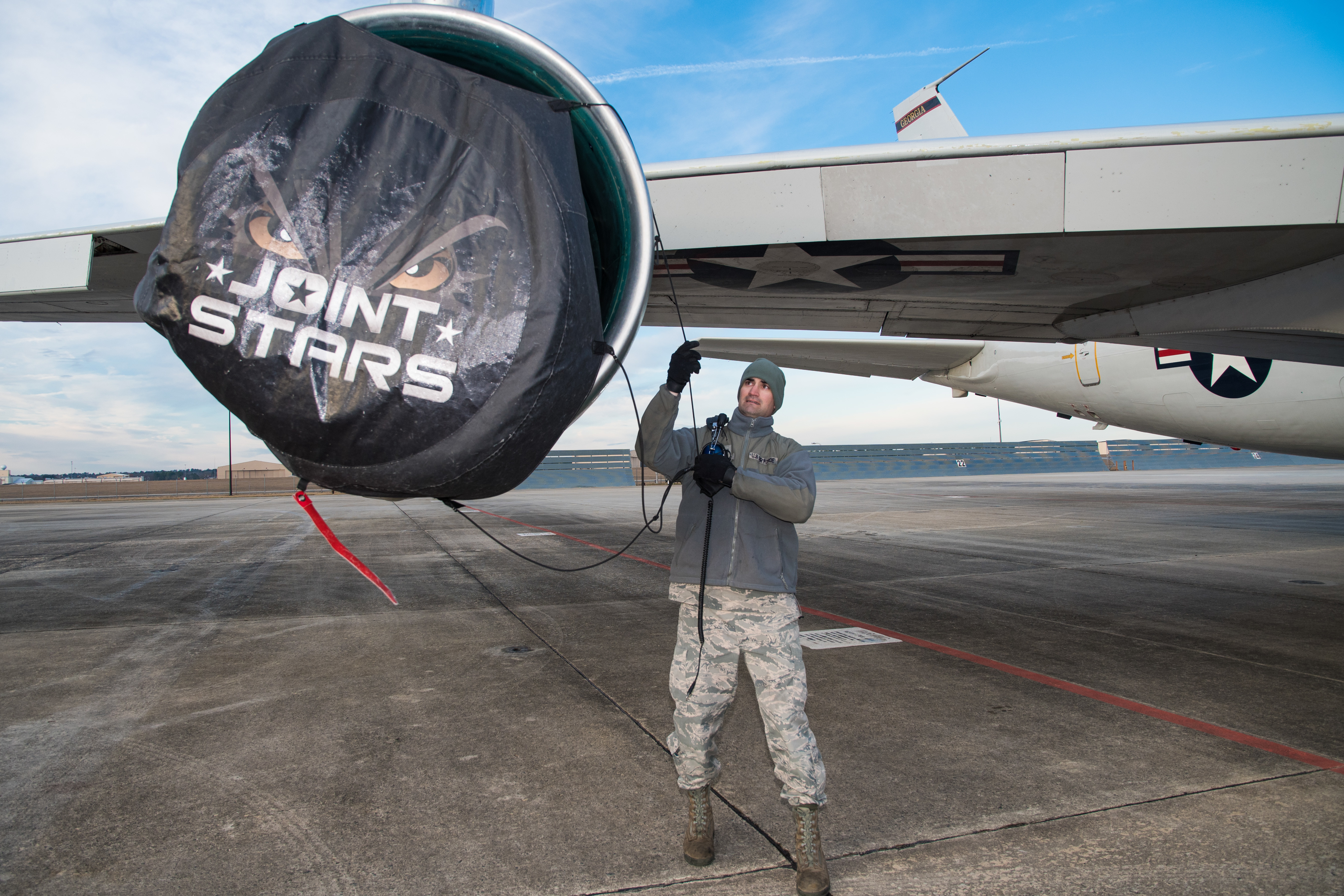
Despite original plans to do so, the Air Force has decided not to recapitalize the JSTARS fleet. Above, SSgt. Justin Estergard, a crew chief with the 461st Aircraft Maintenance Squadron, removes an engine inlet cover on an E-8C Joint STARS during a pre-launch inspection at Robins AFB, Ga., Feb. 8, 2018. ANG photo by SMSgt. Roger Parsons.
The Air Force is requesting $140.7 billion in its base “blue budget,” and an additional $15.6 billion in overseas contingency operations funds. That’s an overall increase of 6.6 percent from the Fiscal 2018 request.
Maj. Gen. John Pletcher, USAF deputy assistant secretary for budget, said the service’s Fiscal 2019 budget request was built off of six key priorities, all of which were designed to accelerate readiness, increase lethality, and enable the service to outpace the advantages of its competitors.
“Readiness is first and foremost about having enough trained people,” said Pletcher. The Fiscal 2019 President’s Budget looks to add 4,700 airmen, bringing the Total Force endstrength to 506,200, including 329,100 Active Duty personnel, up from a projected 325,100 Active Duty in Fiscal 2018.
The budget calls for a 2.6 percent pay raise and continues incentive pays and bonuses, specifically to address gaps in remotely piloted aircraft, cyber, and intelligence career fields. The Air Force has closed its maintainer shortfall and is shifting its attention to building up the experience level in the career field, said Pletcher. The budget also “boosts our training pipeline capacity” and “expands pilot training,” he added. The base budget provides funding for 989 new pilots, helping the service address its growing pilot shortage.
The Fiscal 2019 request includes $8.7 billion to fund some 1.5 million flight hours.
The budget emphasizes the need for an effective nuclear deterrent, including funds to modernize both of USAF’s legs of the nuclear triad as well as nuclear command and control systems. The Fiscal 2019 request includes $280 million—more than double the Fiscal 2018 request ?of $106 million—to upgrade the service’s B-52H fleet. That includes $64.5 million to begin re-engining the aging B-52 fleet, which the service now intends to keep in service into the 2050s.
The budget request also includes a significant boost in funds for the Long Range Stand Off Missile, the next generation cruise missile, increasing funds from $451 million in Fiscal 2018 to $615 million in Fiscal 2019. The Ground Based Strategic Deterrent also sees an increase from $216 million to $345 million. A?dditionally, the service continues development of the new B-21 strike bomber, requesting $2.3 billion in Fiscal 2019, up from $2 billion in Fiscal 2018, though due to the classified nature of the program, officials declined to offer much detail on how that money will be spent.
The third budget priority is cost-effective modernization. Twenty-three pe?rcent—or roughly $3.7 billion—of the service’s aircraft procurement funds are dedicated to modernizing aircraft that are currently in service, including upgrading the F-22A, F-15C/D/E, and F-16C “to remain viable in modern-day contested airspace,” according to budget documents.
The Air Force wants to modernize and improve the cockpit and navigation systems on its E-3 Airborne Warning Command and Control (AWACS) fleet, enabling it to keep the JSTARS fleet in service through the mid-2020s.
However, the Air Force has decided not to recapitalize the JSTARS fleet as originally planned. Pletcher urged reporters on Monday to look at battle management command and control in three increments, though he could not offer a timeline for each of the increments.
The first increment will maintain the JSTARS fleet and then look at taking existing sensors and putting them on additional aircraft, such as the MQ-9, he said. The service wants to find a way to fuse all the sensors that exist today on the ground, in the air, and in space “to provide that information in a battle management command and control perspective that’s not only in JSTARS, but also in the E-3 AWACS,” said Pletcher.
In increments two or three, which Pletcher acknowledged are further in the future and not yet fully defined, that capability may or may not be platform specific.
“It has to be survivable. The whole point of the JSTARS discussion is if we recap the current JSTARS we’ll have an aircraft that still can’t do more than it can today, in fact it’ll probably even be able to do less because it will be in a more competitive and contested environment,” said Pletcher. “The idea is to pull all of these different sensors and essentially create more agility and resiliency in developing that picture for the warfighter.”
The Air Force plans to procure 48 F-35A strike fighters, two more than it requested in Fiscal 2018 and more than half of the Defense Department’s overall F-35 buy in 2019. The budget also funds 15 KC-46 tankers, 10 Combat Rescue Helicopters, six MC-130Js, and one HC-130J. In addition, USAF plans to select a new advanced training aircraft, known as T-X, in 2019.
Military construction, however, takes a hit in Fiscal 2019, dropping $186 million to $1.8 million. Fifty percent of milcon budget goes to new mission beddowns such as the F-35, KC-46 tanker, and a new MQ-9 facility at Shaw AFB, S.C. The service prioritized strengthening the nuclear enterprise, modernizing its ?research, development, and test infrastructure, and combatant commander’s highest construction prioritize, said Pletcher, but “as we continue to take risk in current mission milcon, the Air Force faces a $33 billion bow wave in deferred infrastructure maintenance.”
Overall, the budget highlights “the investments necessary to confront the reemergence of great power competition in a more dangerous international security environment than we have seen in generations,” according to the budget overview. “Future wars will be won by those who observe, orient, decide, and act faster than adversaries in an integrated way and this budget request positions the Air Force to be that force.”